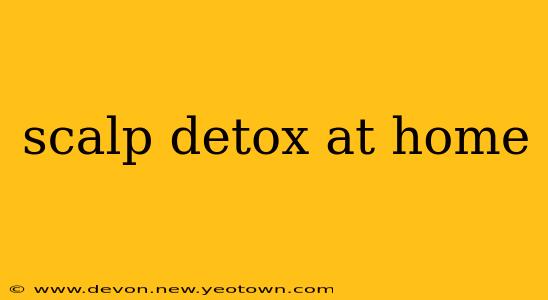Let's be honest, our scalps endure a lot. From daily styling products to environmental pollutants, our hair's foundation often gets neglected. A buildup of product residue, dead skin cells, sweat, and sebum can lead to a host of issues, including dandruff, itching, and even hair loss. But fear not, fellow scalp sufferers! You don't need expensive salon treatments to achieve a deep cleanse. A DIY scalp detox at home is entirely possible, and incredibly rewarding. This comprehensive guide will walk you through everything you need to know to revitalize your scalp and achieve healthier, happier hair.
What is a Scalp Detox?
Before diving into the how-to, let's clarify what a scalp detox actually is. It's a process of gently removing the buildup of dirt, oil, and product residue from your scalp. This allows for better absorption of hair products and promotes a healthier scalp environment, leading to stronger, shinier hair. Think of it as a facial for your scalp!
Why Should I Detox My Scalp?
This is where things get interesting. Many people experience noticeable improvements after a scalp detox, but why? Here are some key benefits:
- Reduces dandruff and itching: Buildup can irritate the scalp, leading to dryness, flaking, and itchiness. A detox helps eliminate these irritants.
- Promotes hair growth: A clean scalp creates a healthier environment for hair follicles to thrive, potentially stimulating hair growth.
- Improves hair texture and shine: Removing buildup reveals healthier hair underneath, resulting in softer, shinier locks.
- Prevents clogged hair follicles: Clogged follicles can lead to ingrown hairs and even infections. A detox helps prevent this.
- Balances oil production: An overly oily scalp can be due to buildup clogging pores. Detoxing can help regulate sebum production.
How Often Should I Detox My Scalp?
The frequency of scalp detoxes depends on your hair type and lifestyle. Generally, a detox once a month or every other month is sufficient for most people. If you use a lot of styling products or have an oily scalp, you may benefit from detoxing more frequently. However, over-detoxing can strip your scalp of its natural oils, leading to dryness and irritation, so listen to your scalp!
What are the Best Home Remedies for Scalp Detox?
Now for the fun part – the actual detox! There are various natural ingredients that work wonders for cleansing and nourishing your scalp. Here are a few popular methods:
Baking Soda and Apple Cider Vinegar (ACV) Scalp Detox:
This classic combo is a favorite for its effectiveness and affordability. Baking soda gently exfoliates the scalp, while ACV balances the pH and adds shine. Mix one tablespoon of baking soda with a little water to form a paste. Apply it to your scalp, massage gently, and rinse thoroughly. Follow up with a diluted ACV rinse (1 part ACV to 1 part water).
Clay Mask Scalp Detox:
Bentonite clay or rhassoul clay are excellent choices for drawing out impurities. Mix the clay with water or apple cider vinegar to create a paste, apply to your scalp, and leave it on for 15-20 minutes before rinsing.
DIY Scalp Scrub:
Combine a mild cleanser with fine granulated sugar or salt to create a gentle scrub. Massage it into your scalp for a few minutes, then rinse thoroughly.
Which Natural Oils Are Good for Scalp Detox?
Many essential oils possess cleansing and soothing properties beneficial for a scalp detox. Tea tree oil is known for its antifungal and antibacterial properties; while rosemary oil can help stimulate hair growth. However, always dilute essential oils in a carrier oil (like coconut or jojoba) before applying them to your scalp to avoid irritation.
Can I Use a Commercial Scalp Detox Product?
Yes! Many commercial scalp detox products are available on the market, offering various ingredients and benefits. Look for products containing natural ingredients like tea tree oil, salicylic acid, or charcoal, and always check the reviews before purchasing. Remember to always follow the instructions provided.
How Long Does it Take to See Results from a Scalp Detox?
You may notice some improvements immediately, such as reduced itchiness or a cleaner feeling scalp. However, seeing more significant changes in hair texture and shine might take a few weeks or even months of regular detoxing. Consistency is key!
What are the Signs of an Unhealthy Scalp?
Keep an eye out for signs like excessive dandruff, persistent itchiness, redness, inflammation, or an unusual amount of oiliness or dryness. These could signal a deeper issue requiring professional advice.
When Should I See a Dermatologist?
If you have persistent scalp issues despite trying home remedies, or if you notice unusual symptoms such as significant hair loss, persistent pain, or visible sores, consult a dermatologist or trichologist. They can help diagnose and treat underlying problems.
Remember, a healthy scalp is the foundation for healthy hair. By incorporating regular scalp detoxes into your hair care routine, you can significantly improve the overall health and appearance of your hair. So, treat your scalp to the TLC it deserves, and enjoy the journey to healthier, happier hair!

